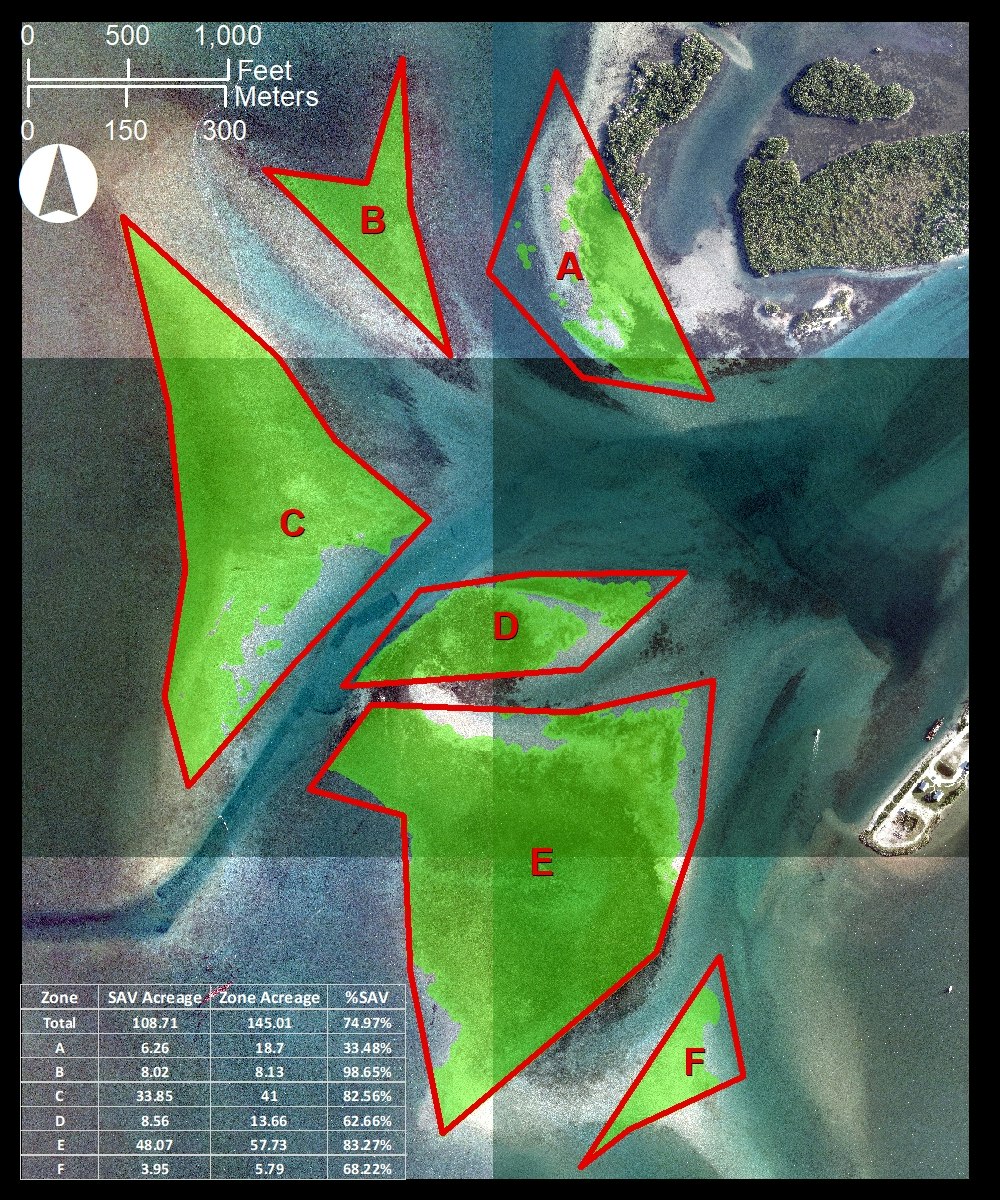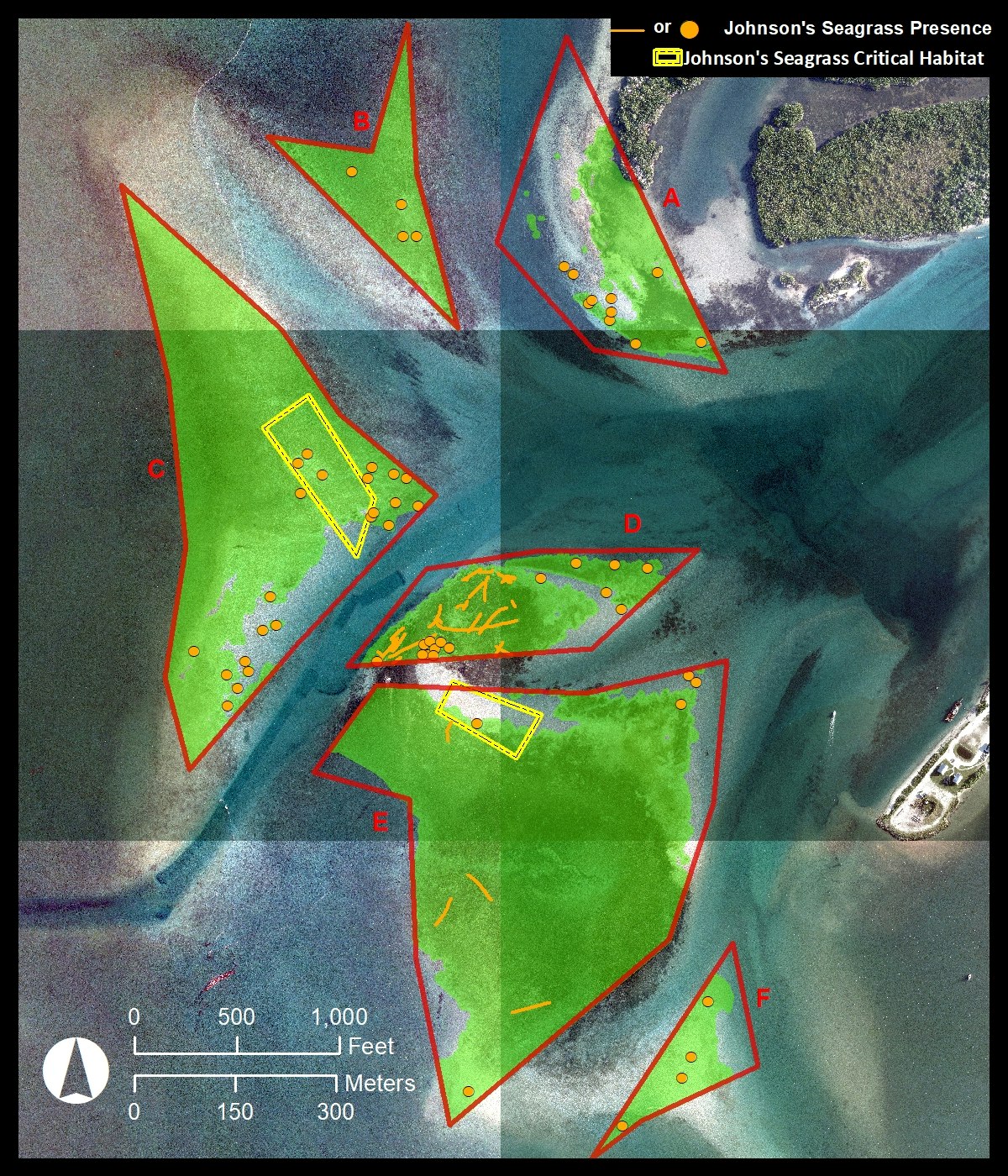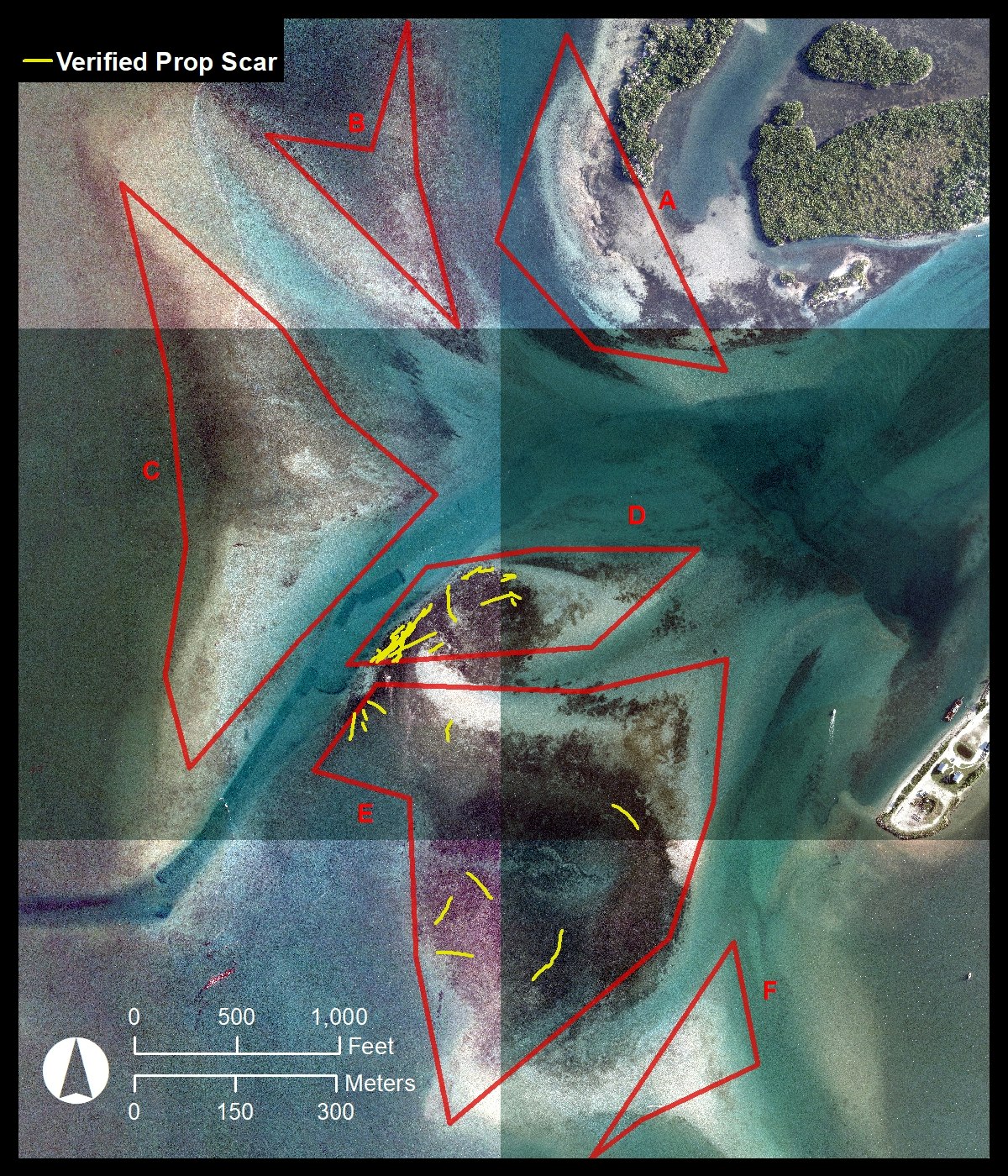Biologists Document Cumulative Gain of 7+ acres of Seagrass at Sebastian Inlet
Based on ground-truthing and subsequent analysis by marine biologists from Atkins North America, a newly released Sebastian Inlet District technical report confirms a cumulative increase of 7.86 acres of seagrass coverage with the protected area on inlet’s western flood tidal shoal from 2018 to 2019, in stark contrast to the Indian River Lagoon-wide trend.
The 145-acre area, divided into six zones and monitored annually, contained six of the seven different species of seagrasses found in the Indian River Lagoon, including shoal grass (Halodule wrightii), manatee grass (Syringodium filiforme), paddle grass (Halophila decipiens), threatened Johnson’s seagrass (Halophila johnsonii), star grass (Halophila engelmannii) and turtle grass (Thalassia testudinum).
Seagrass coverage totaled 108.71 acres in the area surveyed;
ZONE SEAGRASS COVERAGE (acres) TOTAL (acres)
Zone A 6.26 18.7
Zone B 8.02 8.13
Zone C 33.85 41
Zone D 8.56 13.66
Zone E 48.07 57.73
Zone F 3.95 5.79

Shoal grass and Johnson’s seagrass continue to be the dominant species with observed manatee grass returning to the flood tidal shoal in the last few years. Johnson’s seagrass was present at 65% of all sites that contained seagrasses in 2019, up from 43% in 2018. Johnson’s seagrass has been significant in the recovery of seagrasses on the flood tidal shoal and the stability of the shoal as seagrasses recolonize.

Notable in the report, the difference in seagrass species found on the flood tidal shoal before the massive lagoon-wide die-off event in 2011. From 2008 to 2011, the dominant species were manatee grass and shoal grass with Johnson’s seagrass identified in small amounts in two of the six zones. Since 2012, Johnson’s seagrass and shoal grass have dominated, reflective of the fast-growing, pioneering nature of certain species.
“The return of manatee grass could be a sign of recovery. This season, we observed manatee grass at five transects by the channel’s dog-leg and just to the East of it,” said Don Deis, marine biologist from Atkins North America and project lead for 12 years.

The water exchange, or flushing, between the Indian River Lagoon and the Atlantic Ocean has a positive impact on water quality within the lagoon, and has promoted an accelerated resurgence of seagrass beds on the western flood shoal at the inlet as compared to other parts of the lagoon. Those seagrass beds are home to a highly diverse group of plants and animals, including; microscopic bacteria to copepods, shrimp, blue crab and juvenile fish, and 70% of Florida’s marine recreational fish depend on seagrass communities at some point in their life cycle.
Field-work conducted in late July 2019 found that 47% of seagrass coverage consisted of single species patches with the remaining 53% as mixed beds with species combinations. With the exception of Zone E, all other zones exhibited a net increase in seagrass coverage when compared to 2018. Zone C had the highest net increase at 5.43 acres.
“In addition to the annual monitoring and information sharing that has become standard practice for the District, this year’s report also included field data collected along 46 transects before and after the channel dredging project completed last summer for analysis, ” said Sebastian Inlet District Executive Director James Gray. “Protecting seagrass as an important natural resource is critical in our work and post-project surveys show no impacts. We were also encouraged to see areas of new growth after project completion along multiple transects.”
Data collected is shared with partners including the St. John’s River Water Management District to coalesce lagoon-wide data for analysis and year-to-year comparisons.
Biologists also documented 34 prop scars with the majority in Zone D likely representing deviations by boaters navigating the channel from the ICW to the inlet or from those entering a popular anchoring area between Zones D and E.
“Prop scars can be devastating to seagrass beds and take an average of 10 years to heal naturally,” said Gray. “The District placed markers around the six zones reading Caution. Shallow Water. Seagrass Area. and marked the navigational channel in 2008 as an aid to boaters. The District also distributes a free inlet Navigation Guide so boaters can enjoy the area in an environmentally responsible way.”

“People need to know where these sensitive seagrass beds are, understand why protecting them is so important and know that if they run aground, stop the engine, tilt the motor and pole, drift or walk the boat to deeper water. Continued outreach and education are key,” said Deis.
Seagrasses not only act as a nursery and food source for juvenile fish, shellfish and manatees, it improves water quality by trapping and removing sediment and nutrients suspended in the water column. Seagrass roots and rhizomes stabilize sediment in the lagoon bed, and established beds help protect shorelines and limit erosion. The drift algae collected within the seagrass is an important component in the collection of nutrients within the lagoon.
According to the St. John’s River Water Management District, 2.5 acres of seagrasses can support up to 100,000 fish, up to 100 million invertebrates and $5,000-$10,000 in economic activity.
Download the complete, technical report:
Download a copy of the Sebastian Inlet Navigation Guide HERE.
About Seagrasses
Seagrasses are flowering, saltwater plants that live in the shallow areas of an estuarine system, and 7 species of seagrasses are found in the Indian River Lagoon;
Shoal grass (Halodule wrightii) is the most common of seagrasses. Most abundant in shallow water (less than 6.5 feet) and it tolerates a range of salinities. It grows to between 4-10 inches. Shoal grass is considered a pioneer species because it can grow and spread quickly to stabilize the sediment.
Widgeon grass (Ruppia maritime) grows in patches in very shallow water (less than 1 foot) and can be found in areas with low salinity.
Johnson’s seagrass (Halophila johnsonii) is only found in the southern half of the lagoon. Johnson’s seagrass is short, one to two inches long, with paired leaves originating from a single rhizome. It can form dense patches and is found in both shallow and deeper water.
Manatee grass (Syringodium filiforme) is found at mid-depths (5-feet) throughout the lagoon and can grow to lengths of 14 inches. It is rarely found in shallow water and is often in mixed beds with other species.
Paddle grass (Halophila decipiens) is the only species in the lagoon that is annual where blades are lost in cold weather and reemerge in warm weather. It is generally found in deeper water and is most abundant at the southern end of the lagoon.
Star grass (Halophila engelmannii) is generally more common in the northern lagoon and grows at a range of depths, sometimes in mixed beds with other species.
Turtle grass (Thalassia testundinum) can be found in the southern half of the lagoon at mid-depths with flat, ribbon-like blades that grow to 14 inches long and ½ inch wide. Thalassia has the highest requirement for light of all the seagrasses in the lagoon and is an excellent indicator of healthy, stable water quality.
About the Sebastian Inlet District
The Sebastian Inlet District was created in 1919 as an independent special taxing district by act of the Florida State Legislature, and chartered to maintain the navigational channel between the Atlantic Ocean and the Indian River. The Sebastian Inlet District’s responsibilities include state mandated sand bypassing, erosion control, environmental protection and public safety. The Sebastian Inlet supports a rich and diverse ecological environment that is unparalleled in North America. The Inlet is vital not only to the ecological health of the Indian River Lagoon, but it is also an important economic engine for local communities in the region. Known as the premier surfing, fishing, boating and recreational area on the east coast of Florida, the inlet is one of only five navigable channels that connect the Indian River lagoon to the Atlantic Ocean.
Posted: 2/14/2020
